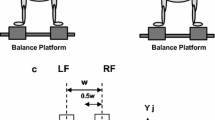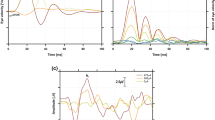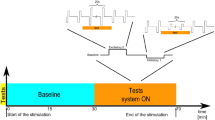Abstract
A multichannel vestibular prosthesis that delivers electrical stimulation to the perilymph of individual semicircular canals is a potential new treatment modality for patients with vestibular deficiencies. Most research in this field has evaluated the efficacy of this approach by its ability to reproduce eye movements in response to head rotations. Our group has developed such a device and implanted it in four human subjects with intractable unilateral Meniere’s disease. This allows us to evaluate individual semicircular canal contribution to the control of balance and posture in human subjects. In this report, we demonstrate that electrical stimulation trains delivered to the perilymph of individual semicircular canals elicit postural responses specific to the particular canal stimulated, with some current spread to adjacent end organs. Modulation of stimulation current modulates the amplitude of the postural response. However, eye movements elicited by the same electrical stimuli were not consistent with postural responses in magnitude or direction in all subjects. Taken together, these findings support the feasibility of a vestibular prosthesis for the control of balance and illustrate new challenges for the development of this technology.








Similar content being viewed by others
References
Baird RA, Desmadryl G, Fernandez C, Goldberg JM (1988) The vestibular nerve of the chinchilla. II. Relation between afferent response properties and peripheral innervation patterns in the semicircular canals. J Neurophysiol 60:182–203
Bilotto G, Goldberg J, Peterson BW, Wilson VJ (1982) Dynamic properties of vestibular reflexes in the decerebrate cat. Exp Brain Res 47:343–352
Black FO, Pesnecker S, Stallings V (2004) Permanent gentamicin vestibulotoxicity. Otol Neurotol 25:559–569
Boyle R, Goldberg JM, Highstein SM (1992) Inputs from regularly and irregularly discharging vestibular nerve afferents to secondary neurons in squirrel monkey vestibular nuclei. III. Correlation with vestibulospinal and vestibuloocular output pathways. J Neurophysiol 68:471–484
Britton T, Day BL, Brown P, Rothwell JC, Thompson PD, Marsden CD (1993) Postural electromyographic responses in the arm and leg following galvanic vestibular stimulation in man. Exp Brain Res 94:143–151
Brodsky MC, Donahue SP, Vaphiades M, Brandt T (2006) Skew deviation revisited. Surv Ophthalmol 51:105–128
Coats AC (1973) Effect of varying stimulus parameters on the galvanic body-sway response. Ann Otol Rhinol Laryngol 82:96–102
Cohen B, Suzuki JI (1963) Eye movements induced by ampullary nerve stimulation. Am J Physiol 204:347–351
Cohen B, Suzuki J, Bender MB (1964) Eye movements from semicircular canal nerve stimulation in cat. Ann Otol Rhinol Laryngol 73:153–169
Courjon JH, Precht W, Sirkin DW (1987) Vestibular nerve and nuclei unit responses and eye movement responses to repetitive galvanic stimulation of the labyrinth in the rat. Exp Brain Res 66:41–48
Dai C, Fridman GY, Della Santina CC (2011a) Effects of vestibular prosthesis electrode implantation and stimulation on hearing in rhesus monkeys. Hear Res 277:204–210
Dai C, Fridman GY, Davidovics NS, Chiang B, Ahn JH, Della Santina CC (2011b) Restoration of 3D vestibular sensation in rhesus monkeys using a multichannel vestibular prosthesis. Hear Res 281:74–83
Davidovics NS, Fridman GY, Chiang B, Della Santina CC (2011) Effects of biphasic current pulse frequency, amplitude, duration, and interphase gap on eye movement responses to prosthetic electrical stimulation of the vestibular nerve, neural systems and rehabilitation engineering. IEEE Trans 19:84–94
Davidovics NS, Rahman MA, Dai C, Ahn J, Fridman GY, Della Santina CC (2013) Multichannel vestibular prosthesis employing modulation of pulse rate and current with alignment precompensation elicits improved VOR performance in monkeys. J Assoc Res Otolaryngol 14(2):233–248
Day BL, Severac Cauquil A, Bartolomei L, Pastor MA, Lyon IN (1997) Human body-segment tilts induced by galvanic stimulation: a vestibularly driven balance protection mechanism. J Physiol 500:661–672
Day BL, Ramsay E, Welgampola MS, Fitzpatrick RC (2011) The human semicircular canal model of galvanic vestibular stimulation. Exp Brain Res 210:561–568
Della Santina C, Migliaccio A, Patel A (2005) Electrical stimulation to restore vestibular function development of a 3-d vestibular prosthesis. Conf Proc IEEE Eng Med Biol Soc 7:7380–7385
Della Santina C, Migliaccio A, Patel A (2007) A multichannel semicircular canal neural prosthesis using electrical stimulation to restore 3-D vestibular sensation. IEEE Trans Biomed Eng 54:1016–1030
Fitzpatrick RC, Day BL (2004) Probing the human vestibular system with galvanic stimulation. J Appl Physiol 96:2301–2316
Goldberg JM (2000) Afferent diversity and the organization of central vestibular pathways. Exp Brain Res 130:277–297
Goldberg JM, Fernandez C (1971) Physiology of peripheral neurons innervating the semicircular canals of the squirrel monkey. III. Variations among units in their discharge properties. J Neurophysiol 34:676–684
Goldberg JM, Smith CE, Fernandez C (1984) Relation between discharge regularity and responses to externally applied galvanic currents in vestibular nerve afferents of the squirrel monkey. J Neurophysiol 51:1236–1256
Gong WS, Merfeld DM (2000) Prototype neural semicircular canal prosthesis using patterned electrical stimulation. Ann Biomed Eng 28:572–581
Gong WS, Merfeld DM (2002) System design and performance of a unilateral horizontal semicircular canal prosthesis. IEEE Trans Biomed Eng 49:175–181
Gong W, Haburcakova C, Merfeld DM (2008) Vestibulo-ocular responses evoked via bilateral electrical stimulation of the lateral semicircular canals. IEEE Trans Biomed Eng 55(11):2608–2619
Guyot JP, Sigrist A, Pelizzone M, Kos MI (2011a) Adaptation to steady-state electrical stimulation of the vestibular system in humans. Ann Otol Rhinol Laryngol 120:143–149
Guyot JP, Sigrist A, Pelizzone M, Feigl GC, Kos MI (2011b) Eye movements in response to electrical stimulation of the lateral and superior ampullary nerves. Ann Otol Rhinol Laryngol 120:81
Guyot JP, Gay A, Izabel Kos M, Pelizzone M (2012) Ethical, anatomical and physiological issues in developing vestibular implants for human use. J Vestib Res 22:3–9
Haque A, Angelaki DE, Dickman JD (2004) Spatial tuning and dynamics of vestibular semicircular canal afferents in rhesus monkeys. Exp Brain Res 155:81–90
Herdman SJ, Blatt P, Schubert MC, Tusa RJ (2000) Falls in patients with vestibular deficits. Am J Otol 21(6):847–851
Highstein SM, Goldberg JM, Moschovakis AK, Fernandez C (1987) Inputs from regularly and irregularly discharging vestibular nerve afferents to secondary neurons in the vestibular nuclei of the squirrel monkey. II. Correlation with output pathways of secondary neurons. J Neurophysiol 75:575–596
Huterer M, Cullen KE (2002) Vestibuloocular reflex dynamics during high-frequency and high-acceleration rotations of the head on body in rhesus monkey. J Neurophysiol 88:13–28
Inglis JT, Shupert CL, Hlavacka F, Horack FB (1995) Effect of galvanic vestibular stimulation on human postural responses during support surface translations. J Neurophysiol 73:896–901
Lewis RF, Merfeld DM, Gong WS (2001) Cross-axis vestibular adaptation produced by patterned electrical stimulation. Neurology 56:A18
Lewis RF, Gong WS, Ramsey M, Minor L, Boyle R, Merfeld DM (2002) Vestibular adaptation studied with a prosthetic semicircular canal. J Vestib Res Equilib Orientat 12:87–94
Lewis RF, Haburcakova C, Gong W, Makary C, Merfeld DM (2010) Vestibuloocular reflex adaptation investigated with chronic motion-modulated electrical stimulation of semicircular canal afferents. J Neurophysiol 103(2):1066–1079
Lewis RF, Nicoucar K, Gong W, Haburcakova C, Merfeld DM (2013) Adaptation of vestibular tone studied with electrical stimulation of semicircular canal afferents. J Assoc Res Otolaryngol 14(3):331–340
Lowenstein O (1955) The effect of galvanic polarization on the impulse discharge from sense endings in the isolated labyrinth of the thornback ray (Raja clavata). J Physiol 127:104–117
Lund S, Broberg C (1983) Effects of different head positions on postural sway induced by a reproducible vestibular error signal. Acta Physiol Scand 117:307–309
Magnusson M, Johansson R, Wiklund J (1990) Galvanically induced body sway in the anterior-posterior plane. Acta Otolaryngol 110:11–17
Mamoto Y, Yamamoto K, Imai T, Tamura M, Kubo T (2002) Three dimensional analysis of human locomotion in normal subjects and patients with vestibular deficiency. Acta Otolaryngol 122(495):500
Minor LB (1998) Gentamicin-induced bilateral vestibular hypofunction. J Am Med Assoc 279:541–544
Minor LB, Lasker DM, Backous DD, Hullar TE (1999) Horizontal vestibuloocular reflex evoked by high-acceleration rotations int he squirrel monkey. I. Normal responses. J Neurophysiol 82:1254–1270
Nashner LM (1993) Computerized dynamic posturography. In: Jacobsen GP, Newman CW, Kartush JM (eds) Handbook of balance function testing. Mosby Year Book, St. Louis, pp 280–308
Nashner LM, Black FO, Wall C (1982) Adaptation to altered support and visual conditions during stance: patients with vestibular deficits. J Neuroscience 2(5):536–544
Nie K, Bierer SM, Ling L, Oxford T, Rubinstein JT, Phillips JO (2011) Characterization of the electrically evoked compound action potential of the vestibular nerve. Otol Neurotol 32(1):88–97
Njiokiktjien C, Folkerts JF (1971) Displacement of the body’s centre of gravity at galvanic stimulation of the labyrinth. Confin Neurol 33:46–54
Olivera LF, Simpson DM, Nadal J (1996) Calculation of area of stabilometric signals using principal component analysis. Physiol Meas 17:305–312
Pastor M, Day B, Marsden C (1993) Vestibular induced postural responses in Parkinson’s disease. Brain 116:1177–1190
Phillips JO, Bierer SM, Ling L, Nie K, Rubinstein JT (2011) Real-time communication of head velocity and acceleration for an externally mounted vestibular prosthesis. IEEE Eng Med Biol Soc 2011:3537–3541
Phillips JO, Shepherd SJ, Nowack AL, Ling L, Bierer SM, Kaneko CRS, Phillips CMT, Nie K, Rubinstein JT (2012) Longitudinal performance of a vestibular prosthesis as assessed by electrically evoked compound action potential recording. IEEE Eng Med Biol Soc 2012:6128–6131
Rubinstein JT, Della Santina CC (2002) Development of a biophysical model for vestibular prosthesis research. J Vestib Res Equilib Orientat 12:69–76
Rubinstein JT, Bierer S, Kaneko C, Ling L, Nie K, Oxford T, Newlands S, Santos F, Risi F, Abbas PJ (2012) Implantation of the semicircular canals with preservation of hearing and rotational sensitivity: a vestibular neurostimulator suitable for clinical research. Otol Neurotol 33:789–796
Severac Cauquil A, Gervet MF, Ouaknine M (1998) Body response to binaural monopolar galvanic vestibular stimulation in humans. Neurosci Lett 245:37–40
Sun DQ, Rahman MA, Fridman GY, Chiang B, Dai C, Della Santina CC (2011). Chronic stimulation of the semicircular canals using a multichannel prosthesis: effects on locomotion and angular vestibulo-ocular reflex in chinchillas. In: Proceedings of the IEEE 33rd annual EMBC conference. 9 Oct 2011
Suzuki JI, Cohen B (1964) Head eye body + limb movements from semicircular canal nerves. Exp Neurol 10:393–405
Thompson LA, Haburcakova C, Gong W, Lee DJ, Wall C, Merfeld DM, Lewis RF (2012) Responses evoked by a vestibular implant providing chronic stimulation. J Vestib Res 22:11–15
van de Berg R, Guinand N, Guyot JP, Kingma H, Stokroos RJ (2012) The modified ampullar approach for vestibular implant surgery: feasibility and its first application in a human with a long-term vestibular loss. Front Neurol 3:18
Wall C, Kos MI, Guyot JP (2007) Eye movements in response to electric stimulation of the human posterior ampullary nerve. Ann Otol Rhinol Laryngol 116:369–374
Wardman DL, Day BL, Fitzpatrick RC (2003) Position and velocity responses to galvanic vestibular stimulation in human subjects during standing. J Physiol 547:293–299
Acknowledgments
The development of the prosthesis was supported by the National Institute on Deafness and Other Communications Disorders contract N01-DC-6-005 and the National Center for Research Resources ITHS ignition award RR00166. This study was supported by the Coulter Foundation, Cochlear, Ltd., and a gift from Sara Kranwinkle. JR is a paid consultant for Cochlear, Ltd., which manufactured and provided the UW/Nucleus vestibular implant. LL, KN, JP, JR, and the University of Washington hold intellectual property rights to the device being studied.
Author information
Authors and Affiliations
Corresponding author
Rights and permissions
About this article
Cite this article
Phillips, C., DeFrancisci, C., Ling, L. et al. Postural responses to electrical stimulation of the vestibular end organs in human subjects. Exp Brain Res 229, 181–195 (2013). https://doi.org/10.1007/s00221-013-3604-3
Received:
Accepted:
Published:
Issue Date:
DOI: https://doi.org/10.1007/s00221-013-3604-3




